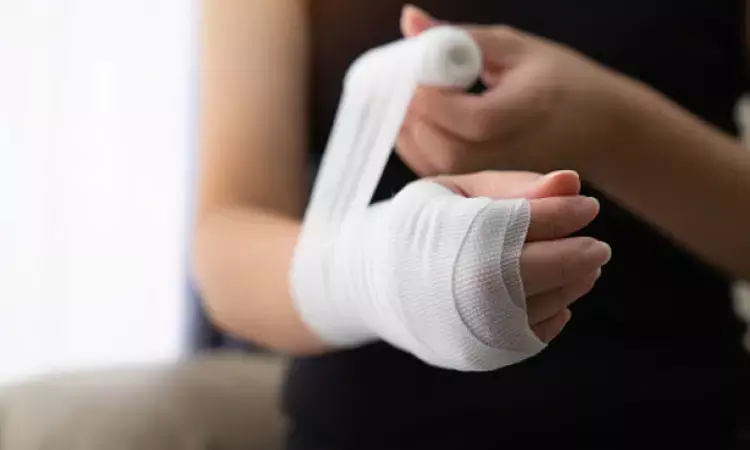- Home
- Medical news & Guidelines
- Anesthesiology
- Cardiology and CTVS
- Critical Care
- Dentistry
- Dermatology
- Diabetes and Endocrinology
- ENT
- Gastroenterology
- Medicine
- Nephrology
- Neurology
- Obstretics-Gynaecology
- Oncology
- Ophthalmology
- Orthopaedics
- Pediatrics-Neonatology
- Psychiatry
- Pulmonology
- Radiology
- Surgery
- Urology
- Laboratory Medicine
- Diet
- Nursing
- Paramedical
- Physiotherapy
- Health news
- Fact Check
- Bone Health Fact Check
- Brain Health Fact Check
- Cancer Related Fact Check
- Child Care Fact Check
- Dental and oral health fact check
- Diabetes and metabolic health fact check
- Diet and Nutrition Fact Check
- Eye and ENT Care Fact Check
- Fitness fact check
- Gut health fact check
- Heart health fact check
- Kidney health fact check
- Medical education fact check
- Men's health fact check
- Respiratory fact check
- Skin and hair care fact check
- Vaccine and Immunization fact check
- Women's health fact check
- AYUSH
- State News
- Andaman and Nicobar Islands
- Andhra Pradesh
- Arunachal Pradesh
- Assam
- Bihar
- Chandigarh
- Chattisgarh
- Dadra and Nagar Haveli
- Daman and Diu
- Delhi
- Goa
- Gujarat
- Haryana
- Himachal Pradesh
- Jammu & Kashmir
- Jharkhand
- Karnataka
- Kerala
- Ladakh
- Lakshadweep
- Madhya Pradesh
- Maharashtra
- Manipur
- Meghalaya
- Mizoram
- Nagaland
- Odisha
- Puducherry
- Punjab
- Rajasthan
- Sikkim
- Tamil Nadu
- Telangana
- Tripura
- Uttar Pradesh
- Uttrakhand
- West Bengal
- Medical Education
- Industry
Percutaneous parallel K-wire, interlocking fixation effective in first metacarpal base fractures

First metacarpal base fractures account for 80% of thumb fractures and 20% of fractures involving the articular surface of the first carpometacarpal joint.
Fractures at the base of the first metacarpal are often unstable and require surgical treatment. Open reduction and internal fixation often damage the ligaments around the joint and affect the blood circulation and joint stability, leading to delayed fracture healing and postoperative cicatrization that affects joint function; therefore, closed reduction is considered superior to open reduction.
The K-wire interlocking fixation technique resists axial rotation and maintains stability, which is beneficial for postoperative hand exercises and function recovery, finds a recent study.
Wu Wang and colleagues from the Department of Orthopedics, Xiangya Hospital, Central South University, Hunan, China aimed to explore the clinical efficacy of treating a first metacarpal base fracture by closed reduction and percutaneous parallel K-wire interlocking fixation between the first and second metacarpals.
The study is published in the Journal of Orthopaedic Surgery and Research.
Twenty patients treated by the above mentioned modified technique (modified technique group) and ten patients treated by the traditional percutaneous K-wire fixation technique (traditional technique group) were retrospectively reviewed. The patients' average age was 38 years.
The mean follow-up period was 13 months. At the final follow-up, the functional recovery of the injured hand was assessed and compared between the modified and traditional technique groups.
In addition, the functional recovery of the injured hand was compared with that of the uninjured hand within the modified technique group.
The authors reported that all patients recovered well, with no cases of infection or nonunion. Compared with the traditional technique group, the modified technique group had a shorter operative time, lower postoperative visual analogue scale pain score, better effective range of motion score of the first carpometacarpal joint, and had almost no need for auxiliary plaster fixation, enabling functional exercise to be started earlier.
Within the modified technique group, the mean hand grip strength, pinch strength, and Kapandji score on the injured side did not significantly differ to the values on the uninjured side in both the extra-articular and intra-articular fracture subgroups.
Furthermore, while the abduction and flexion–extension arcs of the thumb on the injured hand were significantly smaller than those on the uninjured hand in both the extra-articular and intra-articular fracture subgroups, the patients felt clinically well with respect to daily activities and strength.
Hence, this led the authors to conclude that the percutaneous parallel K-wire and interlocking fixation technique is simple, effective, and economical for first metacarpal base fractures.
Dr. Nandita Mohan is a practicing pediatric dentist with more than 5 years of clinical work experience. Along with this, she is equally interested in keeping herself up to date about the latest developments in the field of medicine and dentistry which is the driving force for her to be in association with Medical Dialogues. She also has her name attached with many publications; both national and international. She has pursued her BDS from Rajiv Gandhi University of Health Sciences, Bangalore and later went to enter her dream specialty (MDS) in the Department of Pedodontics and Preventive Dentistry from Pt. B.D. Sharma University of Health Sciences. Through all the years of experience, her core interest in learning something new has never stopped. She can be contacted at editorial@medicaldialogues.in. Contact no. 011-43720751
Dr Kamal Kant Kohli-MBBS, DTCD- a chest specialist with more than 30 years of practice and a flair for writing clinical articles, Dr Kamal Kant Kohli joined Medical Dialogues as a Chief Editor of Medical News. Besides writing articles, as an editor, he proofreads and verifies all the medical content published on Medical Dialogues including those coming from journals, studies,medical conferences,guidelines etc. Email: drkohli@medicaldialogues.in. Contact no. 011-43720751


